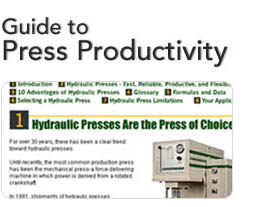« Back
Showroom - Aerospace
>> Recent Aerospace applications
Application:
This particular company produces Intake Fan Blades for a Jet Engine or otherwise commonly known as an Airfoil.
Press Specifications:
| The press is a 100-ton capacity |
| 36" x 36" bed size |
| 20" Daylight |
| 14" Stroke |
| Stroke |
Touchscreen controlled with Electronic Speed Control and
Temperature Functions programmed through the Touchscreen |
| Rapid Advance - 44 IPM |
| Press - Adjustable 9 IPM |
| Rapid Open - 87 IPM |
Material:
- Composite material similar to carbon fiber. The material comes impregnated with the correct amount of resin.
- The hubs are titanium alloy.
- Short shelf life and needs to be refrigerated until laid up in the molds.
Preparation of material:
- A customer developed Composite material sheet is cut using a template to various shapes and sizes but all are the same thickness.
- Using the same template (resembles a topographical map) the previous cut pieces are laid on top of each other in different location with the end hubs sandwiched in the middle. The end result is a part with a varying thickness. The various thicknesses in material are due to machining requirements and attachment requirements of the individual part.
Pressing Sequence:
- The part is placed in a tool that locates the end hubs. The tool is below 100 degrees Fahrenheit (38 C).
- The press has a settable platen temperature for each mold half, time setting for ramping up the temperature from 100 F (38 C) to the maximum required temperature along with a position setting for the Moving Slide for up to 10 sequences.
- The Press then closes to a position setting with a tonnage override to just make contact with the part.
- The Press then closes to a position AND platen temperature (the temperature is set under 365 F (185 C) over a settable time (generally 0-30 min). The press will achieve the set position and temperature at the exact end of the sequence.
- This continues with decreasing positions and increasing temperatures.
- When the tool reaches a set temperature the press goes into tonnage control.
- The temperature then begins to cool by convection at a controlled rate through the use of Water Cooling Channels provided in the Heated Platens of the press.
- At a settable sequence cooling water is turned on to cure the part and set the contours of the tooling and bring the tooling temperature below 100 degrees.
The process is called SMC or Sheet Molding Compound. This is a very popular form of Compression Molding where the "Charge" (SMC material being loaded into the die to be molded) is a pasty type of material. SMC compounds have a short shelf life (usually around 30 days or less) before they can no longer use it. The SMC compound is made from a variety of materials but the strength of it comes from the Fiberglass strands that are mixed into the paste. The paste usually comes in rolls that the operator will roll out and cut to length depending on the size of the charge required. They tend to fold the charge over into a smaller packet and they will place from one to several charges into the mold depending on the final part size.
The important factor in producing a good part is that the mold must be closed pretty quickly upon placing the charge in it or the charge begins to cure and will not flow into the cavities of the mold. Upon the mold closing, the charge liquefies from the heat and fills the cavities of the mold until it is completely filled. Thereupon we bring in a "Bump" cycle. This Bump cycle relieves pressures and gases from the mold internally. We don't open the press; we just relax the pressure to allow the gases to escape. We then control the pressure on the mold specific to the customer's process requirements. This could mean multiple pressures for varying lengths of time as stated above.

|


















